Table of Contents
- Introduction
- Editor’s Choice
- History of Organ Donation
- Organ Transplantation Statistics
- Regional Organ Donation Statistics
- Kidney Donation Statistics
- Liver Donation Statistics
- Heart Donation Statistics
- Lung Donation Statistics
- Demographics of Organ Donors
- Organ Transplants: Donation After Brain Death – By Organ Statistics
- Deceased Organ Donor Rate After Brain Death (DBD) and Donation After Cardiac Death (DCD)
- Candidates Waiting for Organ Transplants
- Key Cost Metrics
- Important Sources of Information on Organ Donation Statistics
- Investments in Organ Donation Statistics
- Popular Organ Donation Programs Statistics
- Regulations for Organ Donation Statistics
- Recent Developments
- Conclusion
- FAQs
Introduction
Organ Donation Statistics: Organ donation is the process of transferring organs or tissues from a donor to a recipient in need due to organ failure.
It can involve living donors, such as those who donate a kidney or liver portion, or deceased donors, where organs are recovered after brain or cardiac death.
However, the process includes identifying suitable donors, obtaining consent, matching organs with recipients, and performing surgeries.
Organ donation is regulated to ensure ethical practices and fair access but faces challenges such as a shortage of donors and ethical concerns. Public awareness and education efforts aim to address these challenges and increase donor registration.
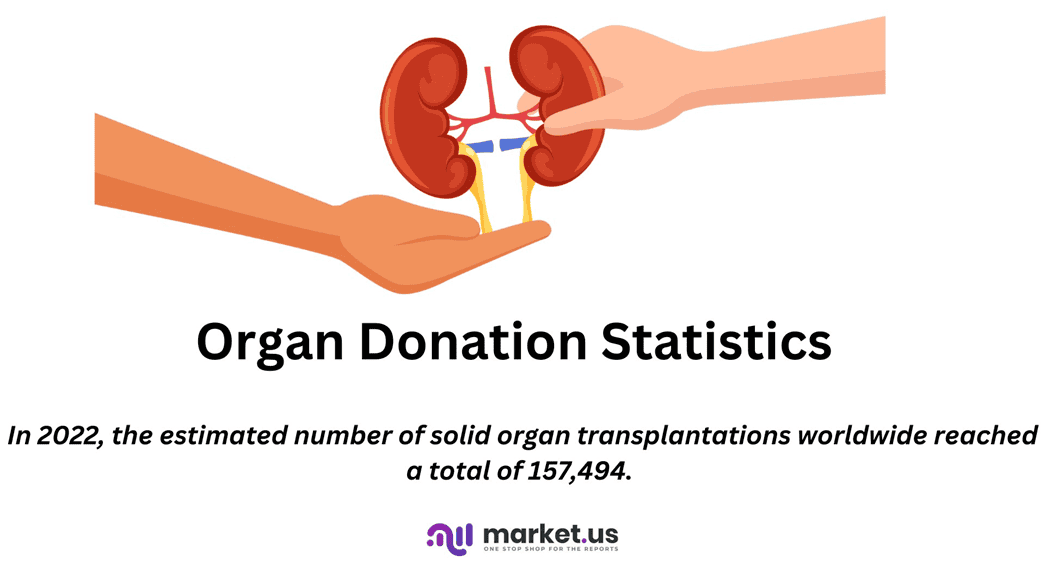
Editor’s Choice
- The Tissue And Organ Transplantation Market Size is projected to reach approximately USD 44 billion by 2033, showing significant growth from the 2023 figure of USD 17.7 billion.
- This represents a Compound Annual Growth Rate (CAGR) of 9.5% anticipated during the forecast period spanning from 2024 to 2033.
- In 2022, the estimated number of solid organ transplantations worldwide reached a total of 157,494.
- In 2022, the distribution of organ transplants worldwide varied significantly by organ type. Kidney transplants comprised the largest share, accounting for 65% of the total.
- Moreover, In 2023, Spain led the world in deceased organ donors per million population, with a rate of 49.38.
- In a survey measuring the willingness of individuals to allow organ removal in the event of sudden death, Colombia topped the list, with 75% of respondents expressing their consent.
- In the United Kingdom (UK), during 2022/23, organ donors by age group were distributed in a diverse range. Donors aged 18-49 constituted the largest share at 36%.
- As of November 2023, the number of candidates waiting for organ transplants in the United States totaled 103,650.
- The Health Resources and Services Administration (HRSA) proposed a $36 million increase in the fiscal year 2024 budget, totaling $67 million for organ procurement and transplantation modernization initiatives.

History of Organ Donation
- The history of organ donation is marked by significant milestones and innovations that have advanced the field dramatically.
- In 1954, the first successful human organ transplant was performed with a kidney between identical twins.
- This breakthrough was followed by the first successful liver and pancreas transplants in 1967 and the first heart transplant performed by Dr. Christiaan Barnard the same year.
- The establishment of the Southeast Organ Procurement Foundation (SEOPF) in 1968 introduced a computer-based organ matching system, which evolved into the United Network for Organ Sharing (UNOS) in 1984 under the National Organ Transplant Act. This act created a structured and ethical framework for organ recovery and allocation.
- The development of immunosuppressive drugs like Cyclosporine in the 1980s significantly reduced organ rejection rates, leading to more successful transplants.
- Further advancements included the first successful heart-lung transplant in 1981, the first double-lung transplant in 1986, and the first living donor liver and lung transplants in the late 1980s and early 1990s.
- By 2021, the US achieved over 40,000 transplants in a single year, highlighting the continuous progress and the increasing generosity of donors.
- This historical evolution reflects a journey of medical breakthroughs and collaborative efforts that have saved countless lives.
(Sources: UNOS, History, Mid-America Transplant, LifeCenter Organ Donor Network, Timetoast Timelines)
Organ Transplantation Statistics
Number of Organ Donation/Transplantation Worldwide Statistics
- In 2022, the estimated number of solid organ transplantations worldwide reached a total of 157,494.
- Among these, kidney transplants were the most prevalent, accounting for 102,090 procedures.
- Liver transplants followed with 37,436 cases.
- Heart transplants were also significant, with 8,988 operations performed.
- Lung transplants totaled 6,784, while pancreas transplants accounted for 2,026 procedures.
- The number of small bowel transplants was comparatively low, with only 170 cases recorded.
- This data reflects the global distribution and demand for various organ transplants, highlighting the critical need for continued advancements and support in transplantation medicine.
(Source: Statista)
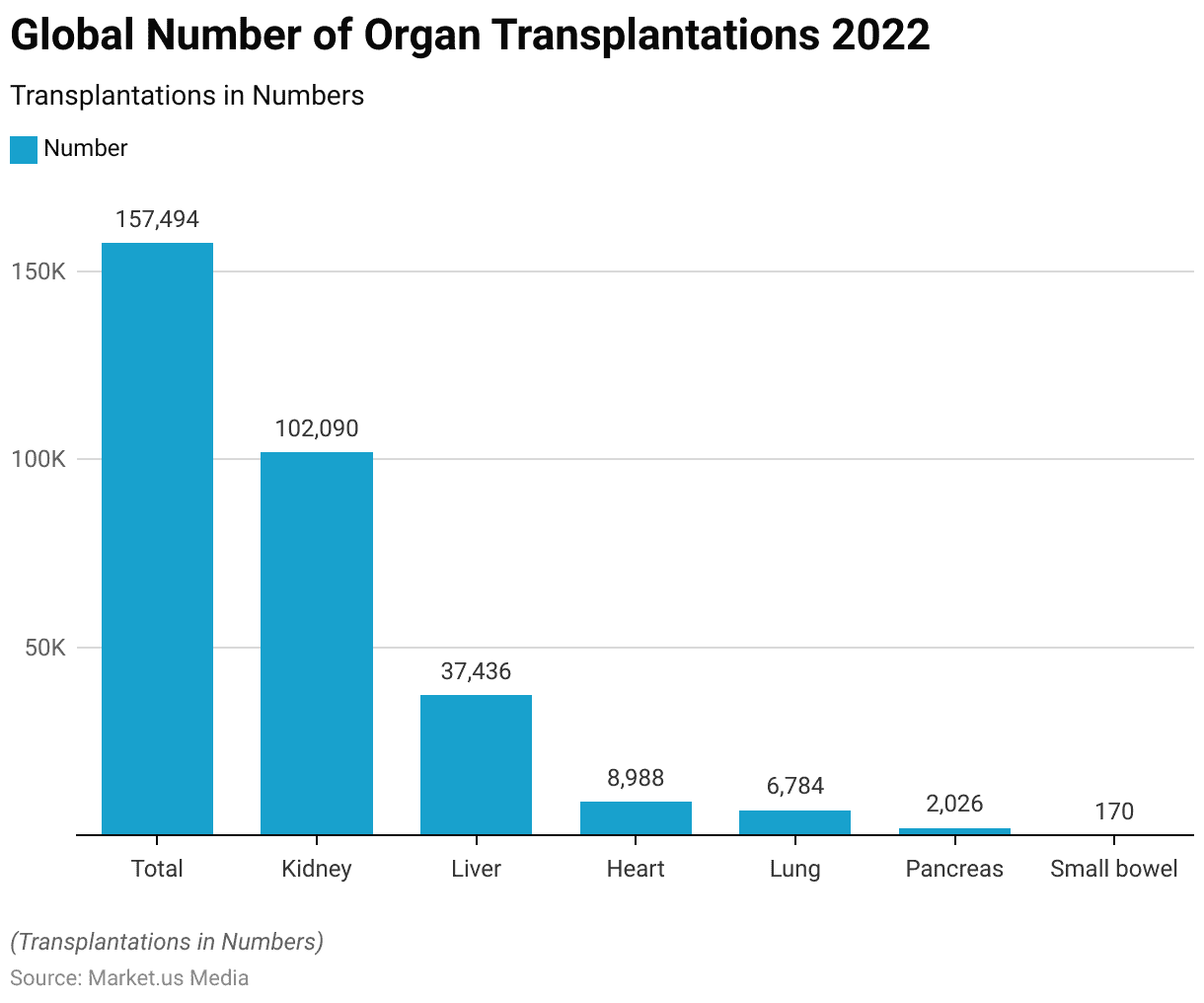
Distribution of Organ Transplants – By Organ Donation Type Statistics
- In 2022, the distribution of organ transplants worldwide varied significantly by organ type. Kidney transplants comprised the largest share, accounting for 65% of the total.
- Liver transplants followed, representing 24% of the global total.
- Heart transplants constituted 6% of the overall figure, while lung transplants made up 4%.
- Pancreas transplants were relatively rare, comprising 1% of the total transplants performed.
- Small bowel transplants were the least common, representing a negligible 0% of the overall distribution.
- This distribution underscores the predominant demand for kidney and liver transplants compared to other organ types.
(Source: Statista)
Take advantage of our unbeatable offer - buy now!

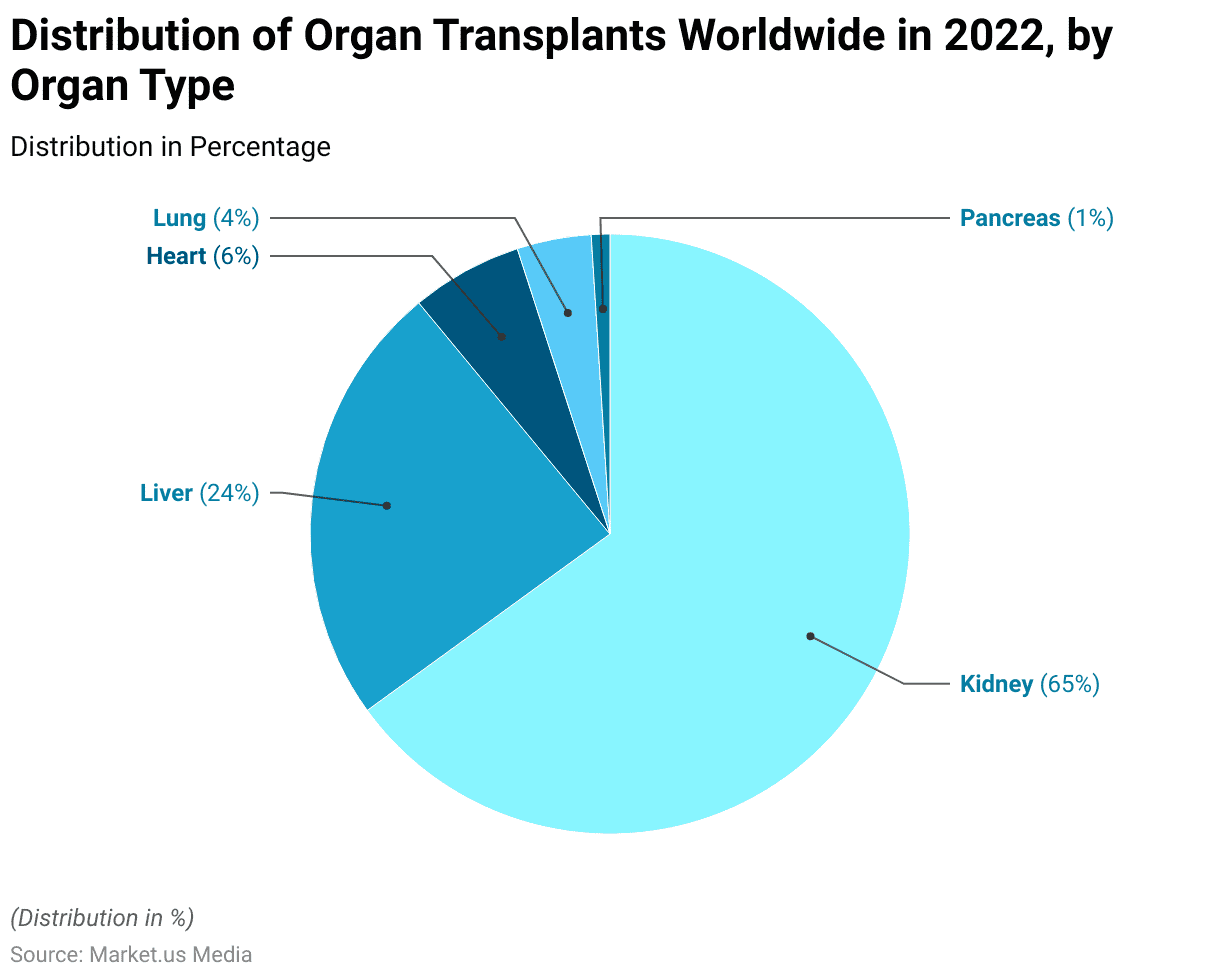
Regional Organ Donation Statistics
Deceased Organ Donation – By Country Statistics
- In 2023, Spain led the world in deceased organ donors per million population, with a rate of 49.38.
- Close behind was the United States, with 48.04 donors per million.
- Portugal and Belgium also demonstrated high rates of organ donation, with 36.93 and 35.81 donors per million, respectively.
- Slovenia reported a rate of 30.95, while Croatia had 29.00 donors per million.
- The Czech Republic followed with 28.48 donors per million, and Belarus had a rate of 25.26.
- Estonia and Switzerland had similar rates, with 23.08 and 22.73 donors per million, respectively.
- Austria recorded 20.89 donors per million, and Lithuania had 20.00.
- Uruguay reported 19.71 donors per million, followed by Australia with 19.43, and Brazil with 18.65 donors per million population.
- This data highlights the varying levels of deceased organ donation across different countries.
(Source: International Registry on Organ Donation and Transplantation (IRODaT))
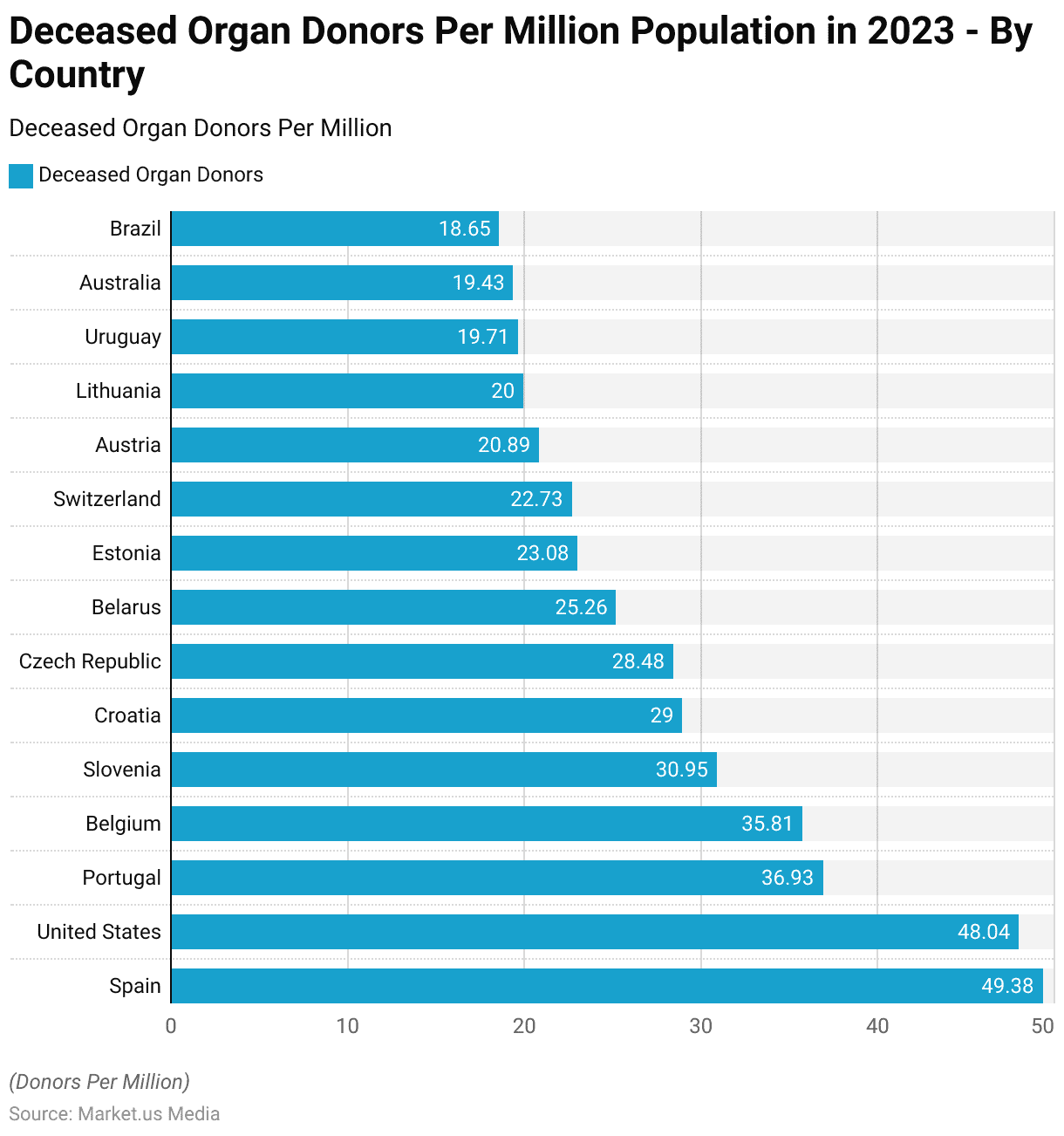
Living Organ Donation Donor Rate – By Country Statistics
- In 2023, Turkey had the highest rate of living organ donors, with 53.8 donors per million population (pmp).
- Saudi Arabia followed with a rate of 46.42 pmp, and Israel had 34.02 pmp.
- The Netherlands reported a living organ donor rate of 30.34 pmp.
- The United States recorded 20.45 pmp, while Kuwait and Mexico had rates of 18.6 pmp and 17.01 pmp, respectively.
- Georgia and Syria both had living donor rates around 15 pmp, with 15.41 and 15.00 pmp, respectively; New Zealand also reported the latter rate.
- Cyprus had a rate of 13.08 pmp, and Switzerland recorded 12.50 pmp.
- Greece and Vietnam reported lower rates, with 10.00 pmp and 9.65 pmp, respectively, while Australia had a living organ donor rate of 9.58 pmp.
- This data reflects significant variations in living organ donation practices across different countries.
(Source: International Registry on Organ Donation and Transplantation (IRODaT))
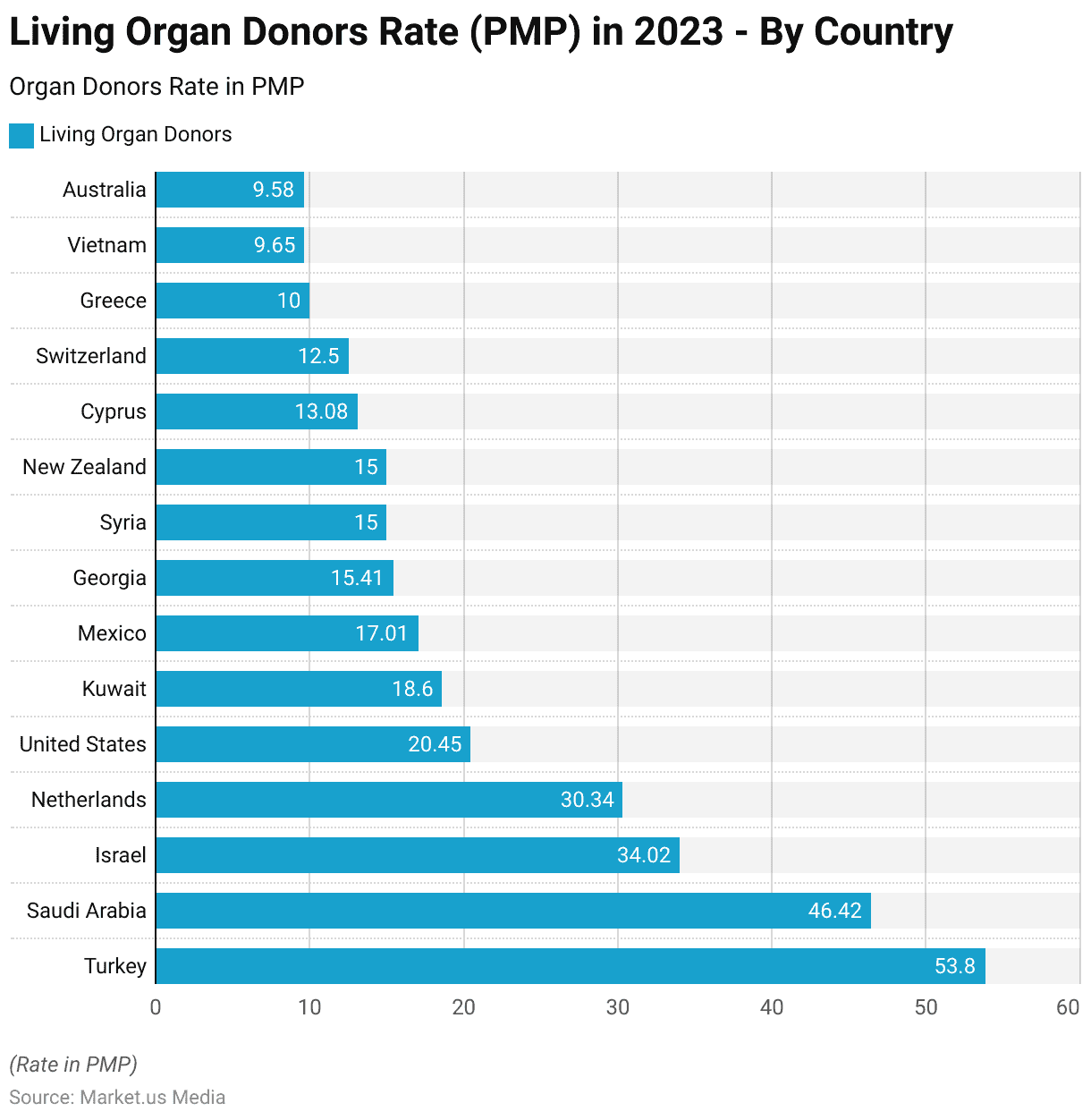
Individuals Willing to Allow Organ Removal in Case of Sudden Death – By Country
- In a survey measuring the willingness of individuals to allow organ removal in the event of sudden death, Colombia topped the list, with 75% of respondents expressing their consent.
- India followed closely with 74%, while in Spain, 72% of individuals were willing to donate their organs.
- In Canada, the figure stood at 69%, and in Australia, it was 68%.
- Great Britain reported a willingness rate of 67%, and in Italy, 66% of respondents were open to organ donation.
- In the United States, 65% of people indicated their consent.
- China had a slightly lower rate at 62%, followed by France at 57% and Germany at 53%.
- In Saudi Arabia, the percentage was 44%, while South Korea and Japan reported lower rates of 39% and 33%, respectively.
- Russia had the lowest percentage, with only 30% of individuals willing to allow organ removal in case of sudden death.
- This data highlights significant differences in attitudes towards organ donation across various countries.
(Source: Ipsos Survey)
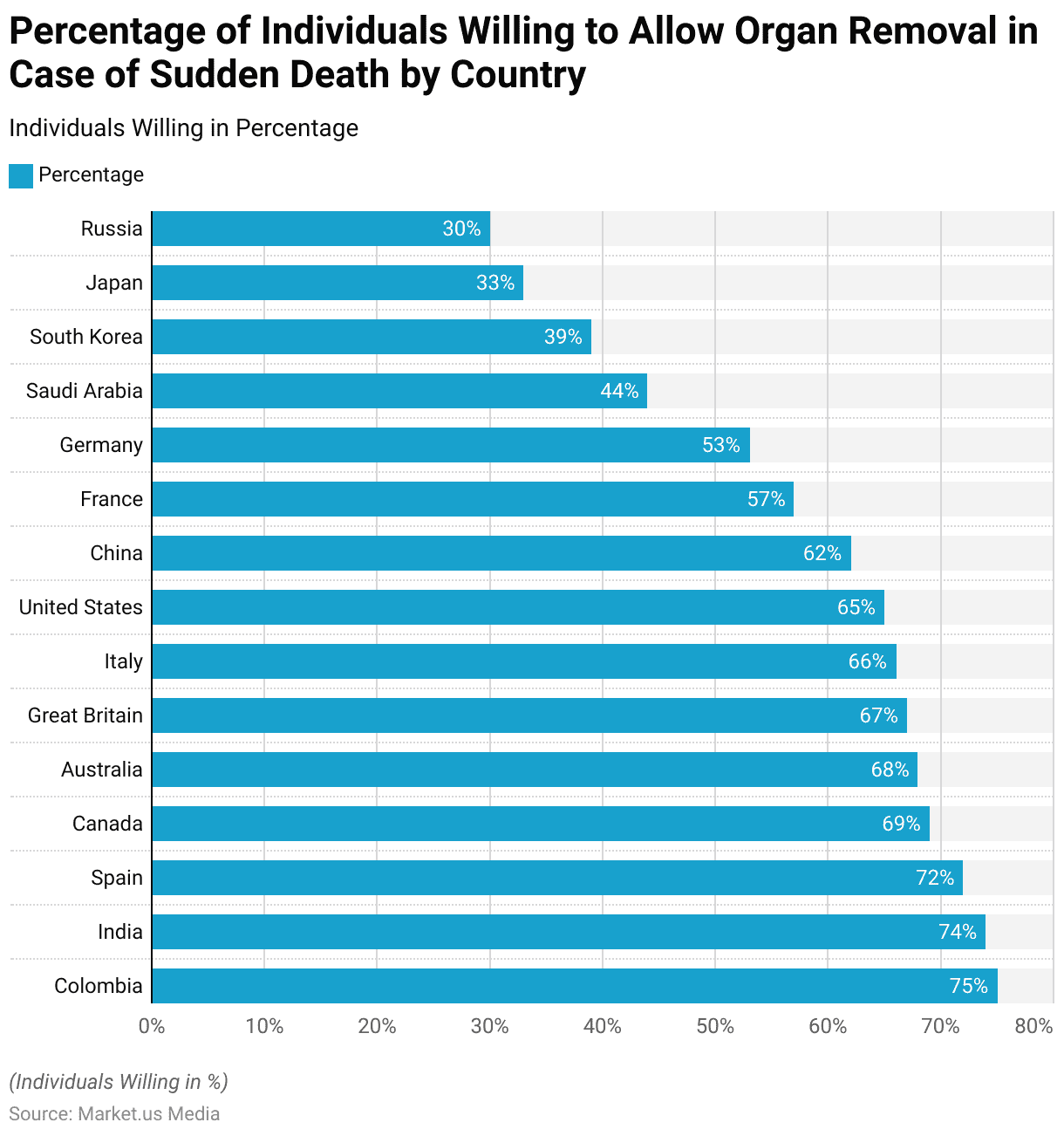
Kidney Donation Statistics
Organ Donation Rate of Kidney Transplant Activities Worldwide Statistics
- Between 2011 and 2022, the rate of kidney transplants per million populations worldwide exhibited a general upward trend with some fluctuations.
- In 2011, the rate was 11 transplants per million populations, which slightly increased to 11.1 in 2012 and 11.2 in 2013.
- The rate remained stable at 11.1 in 2014, followed by a modest rise to 11.3 in 2015.
- A more significant increase occurred in 2016, with the rate reaching 12.1, but it slightly decreased to 12 in 2017.
- A notable jump was observed in 2019, with the rate surging to 17.2.
- However, in 2020, the rate dropped to 13, likely due to the impacts of the COVID-19 pandemic.
- The rate rebounded in 2021, climbing to 15.4, and continued to rise in 2022, reaching 17.1 transplants per million population.
- This data reflects the overall growth in kidney transplantation rates over the decade despite the temporary decline during the pandemic year.
(Source: Statista)
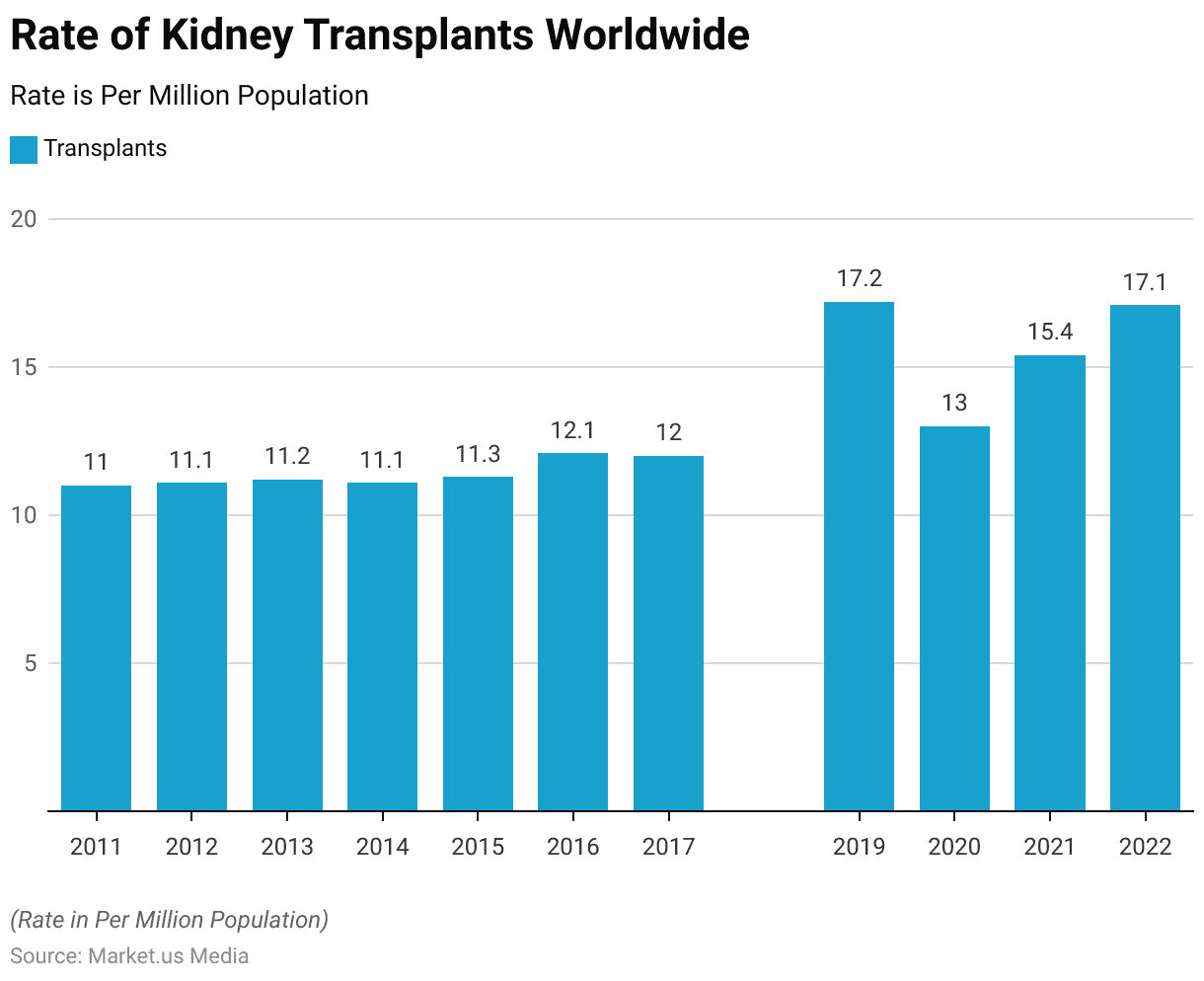
Organ Donation Global Kidney Transplants – By Region Statistics
- In 2022, the estimated number of kidney transplants performed worldwide varied significantly by region.
- The Americas led with 39,196 kidney transplants.
- Europe, including countries from the former Soviet Union, followed with 25,329 transplants.
- The Western Pacific region reported 18,219 kidney transplants, while Southeast Asia accounted for 12,696 procedures.
- In the Eastern Mediterranean region, 6,364 kidney transplants were performed. Africa had the lowest number, with only 286 kidney transplants conducted.
- This data underscores the regional disparities in access to kidney transplantation services globally.
(Source: Statista)

Liver Donation Statistics
Organ Donation Global Liver Transplants – By Region Statistics
- In 2022, the number of liver transplants performed worldwide displayed significant regional variation. The Americas led with 13,387 liver transplants.
- Europe, including countries from the former Soviet Union, followed with 9,840 transplants.
- The Western Pacific region reported 8,325 liver transplants, while Southeast Asia accounted for 4,067 procedures.
- The Eastern Mediterranean region performed 1,817 liver transplants. Notably, Africa did not report any liver transplants.
- This data highlights the disparities in liver transplantation services across different regions globally.
(Source: Statista)

Liver Transplants from Deceased Donors – By Country
- In 2023, the rate of liver transplants from deceased organ donors per million population varied across countries.
- The United States led with a rate of 29.41 per million population.
- Belgium and Croatia followed closely with rates of 26.84 and 26.75, respectively.
- Spain reported a rate of 26.52, and Portugal had 24.36 per million population.
- The Czech Republic recorded a rate of 17.24, while Switzerland had 16.48.
- Estonia and Austria reported similar rates, with 13.08 and 13.00, respectively.
- Poland had a rate of 12.93, and Lithuania reported 11.11 per million population.
- Slovenia and Australia had rates of 10.95 and 10.87, respectively, while New Zealand recorded a rate of 10.58.
- The Netherlands had the lowest rate among these countries, with 10.11 per million population.
- This data illustrates the differences in liver transplant rates from deceased donors across various nations.
(Source: International Registry on Organ Donation and Transplantation (IRODaT))
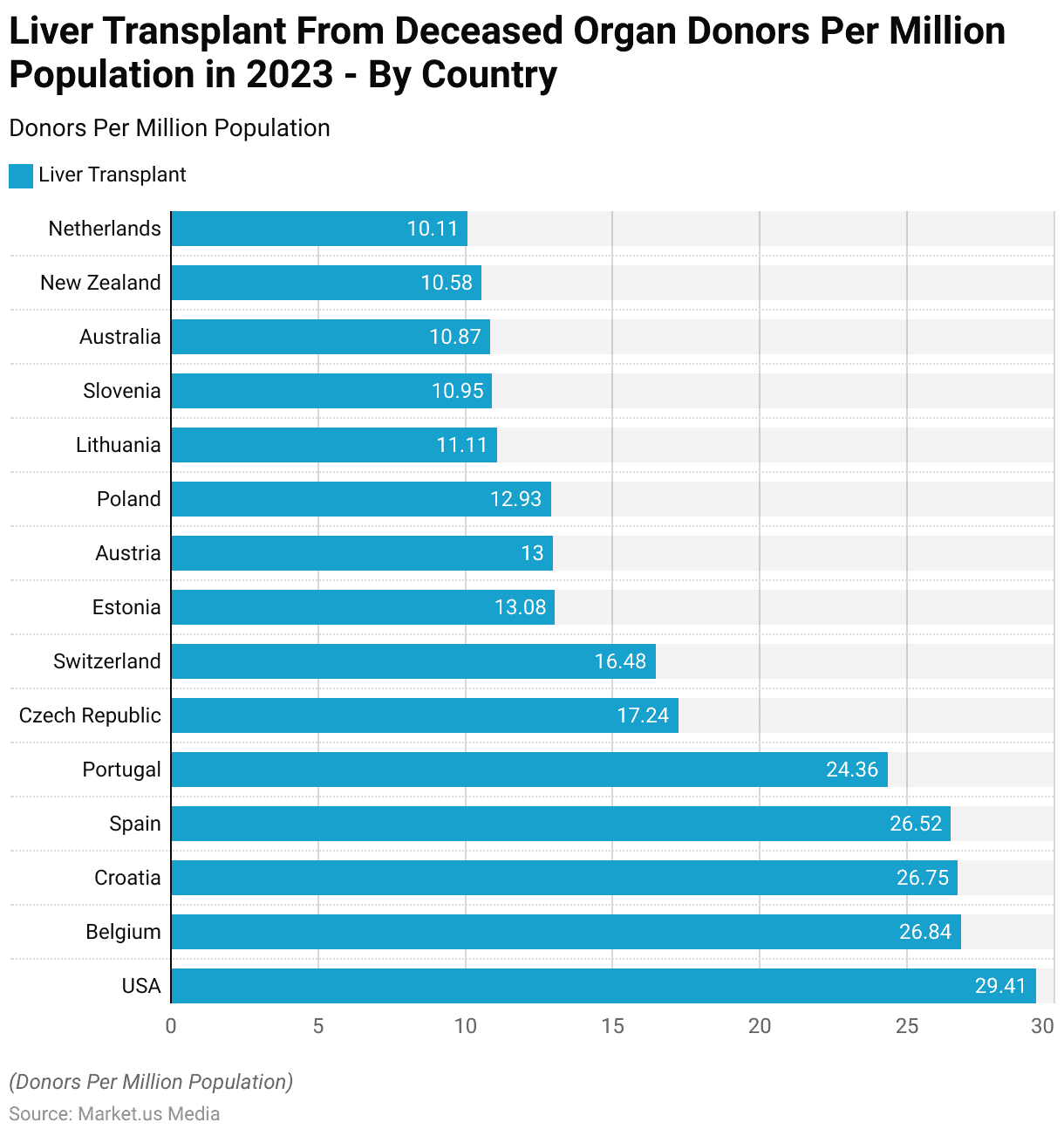
Heart Donation Statistics
Rate of Heart Transplants Worldwide
- Between 2011 and 2022, the rate of heart transplants worldwide showed a gradual increase.
- In 2011 and 2012, the rate was steady at 0.8 transplants per million populations.
- This rate rose to 0.9 in 2013 and remained stable through 2015.
- A further increase occurred in 2016 and 2017, with the rate reaching one transplant per million populations.
- In 2019, the rate saw a significant jump to 1.5.
- However, the COVID-19 pandemic in 2020 caused a slight decline to 1.3.
- The rate rebounded in 2021 to 1.4 and maintained its upward trend, returning to 1.5 transplants per million populations in 2022.
- This data reflects a consistent growth in the global rate of heart transplants over the decade, with a temporary dip during the pandemic year.
(Source: Statista)
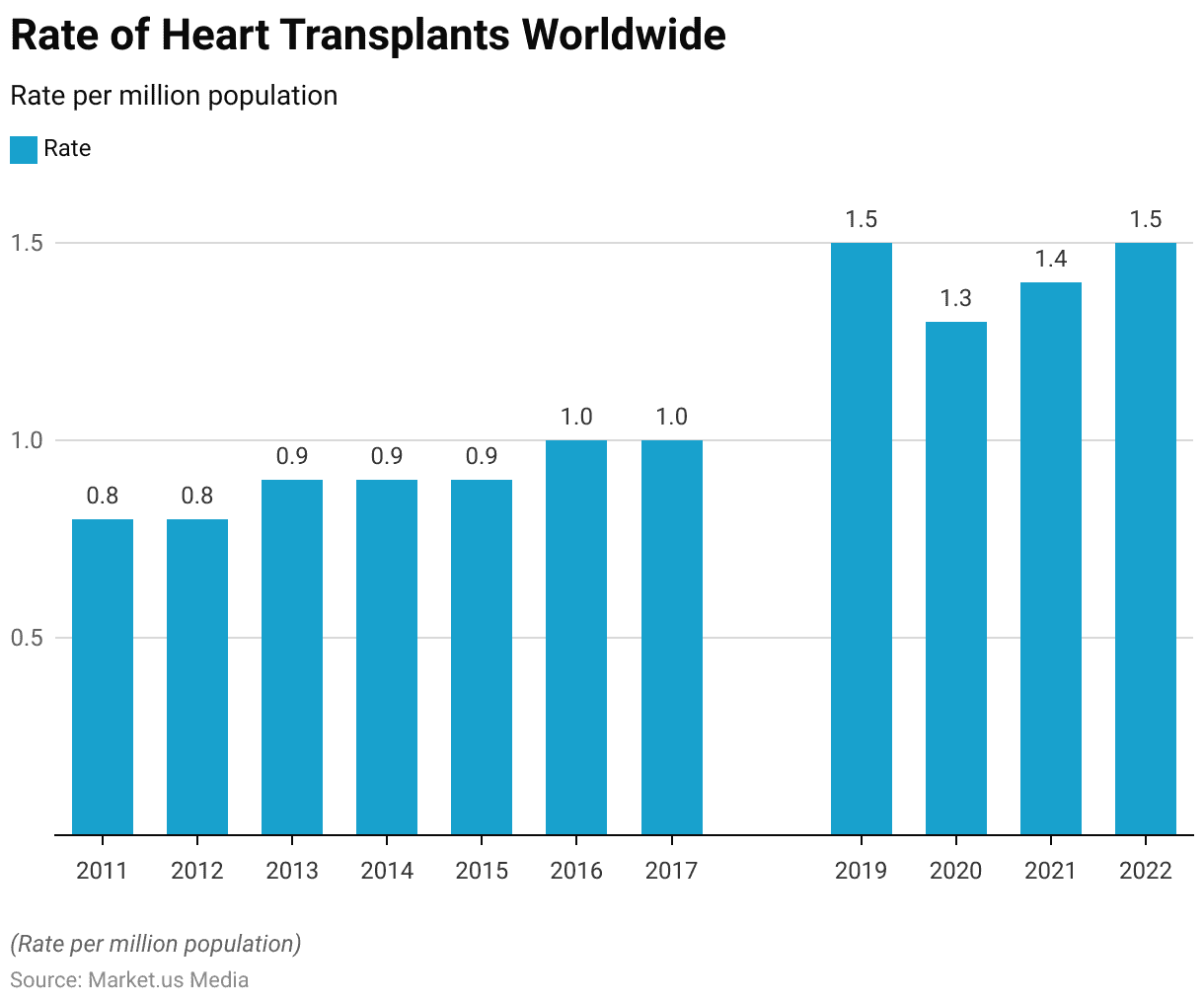
Recovery from Heart Donation and Related Factors
- Despite the pandemic, the US saw an increase in recovered hearts for transplantation, particularly among donors aged 18-29 and 30-39 years.
- In 2021, 3,901 hearts were recovered, with the majority coming from these age groups (35.1% and 29.8%, respectively).
- Pediatric and older donors declined to 13.4% and 1.8%, respectively.
- The share of female donors has slightly decreased since 2010, while racial and ethnic diversity remained unchanged.
- Hearts recovered from donors who died of anoxia increased steadily over the past decade, comprising 45.0% in 2021, followed by head trauma at 40.8%. The non-use rate of recovered hearts was low at 1.02%.
- Non-use rates have generally risen over the past decade, with higher non-use among donors aged 30-39 (1.7%), males (1.2%), those with hypertension (1.9%), BMI ≥40 kg/m² (4.3%), cerebrovascular accidents/strokes (1.7%), or other/unknown causes (2.3%).
- Despite these trends, non-use rates for heart transplants are notably lower than for other organs.
(Source: US Department of Health and Human Services (HHS))
Lung Donation Statistics
Number of Lung Transplantations – By Region
- In 2022, the estimated number of lung transplantations worldwide varied significantly by region.
- The Region of the Americas led with 3,313 lung transplants, followed by the European Region with 2,073 procedures.
- The Western Pacific Region reported 1,199 lung transplants.
- The Southeast Asian Region accounted for 144 lung transplants, while the Eastern Mediterranean Region recorded 55 procedures.
- Notably, the African Region did not report any lung transplants.
- This data highlights the regional disparities in lung transplantation services across the globe.
(Source: Statista)
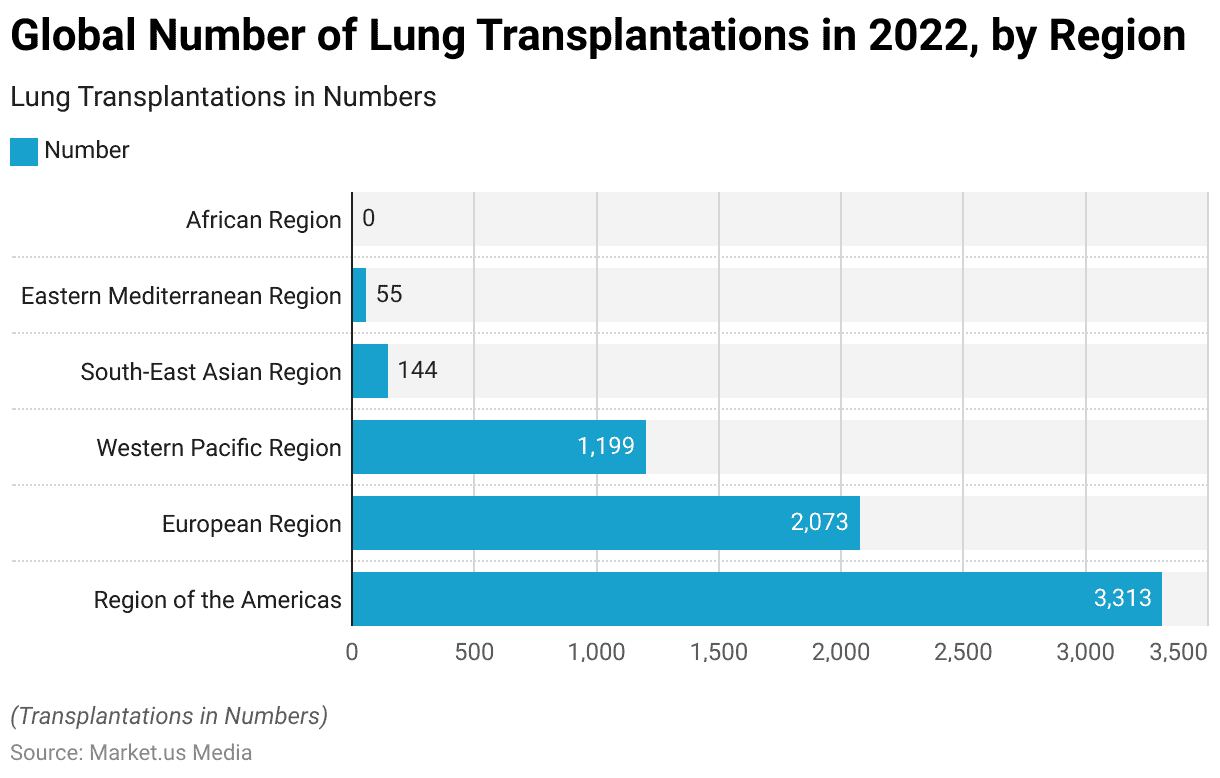
Recovery from Lung Donation and Related Factors
- A study found that lung donors recovered in independent donor centers (DCUs) were less likely to have documented pulmonary infections during management compared to those from hospital-based DCUs (68.0% vs. 77.8%).
- Among 1,657 lung recipients (average age 58.6 years; 1,068 males, 589 females), 75.4% received lungs from independent DCUs, while 24.6% received from hospital-based DCUs.
- Recipients of lungs from independent DCUs had better survival outcomes, including higher rates of chronic obstructive pulmonary disease (27.1% vs. 21.6%) and lower rates of restrictive lung disease (62.3% vs. 71.0%).
- In survival analyses of lung transplant recipients from donor centers (DCUs), the median follow-up was 734 days overall and 762 days for censored outcomes.
- There were 451 deaths, 19 retransplants, and six lost to follow-up (all from independent DCUs). Graft loss was higher for lungs from independent DCUs compared to hospital-based DCUs (30.2% vs. 22.9%).
- Most donation outcomes were comparable between independent and hospital-based DCUs, though median donor management time was shorter in independent DCUs (49 vs. 61 hours). Secondary outcomes, such as mechanical ventilation at 72 hours and 1-year graft survival, were similar for recipients from both DCU types.
(Source: JAMA Network)
Demographics of Organ Donors
By Age
- In the United Kingdom (UK), during 2022/23, organ donors by age group were distributed in a diverse range.
- Donors aged 18-49 constituted the largest share at 36%.
- The 50-59 age group followed, accounting for 25% of donors.
- Those aged 60-69 represented 23% of the donor population, while donors aged 70 and over made up 14%.
- The youngest age group, 0-17, contributed 3% to the total number of organ donors.
- This data indicates a broad participation across different age groups in organ donation within the UK.
(Source: Statista)

By Gender
- Between 2013 and 2023, the number of organ donors in the United States showed a notable increase for both genders.
- In 2013, there were 7,016 female donors and 7,242 male donors. This number gradually increased each year.
- By 2014, female donors had risen to 7,063 and male donors to 7,353.
- The upward trend continued with 7,347 female and 7,721 male donors in 2015 and 7,773 female and 8,178 male donors in 2016.
- In 2017, there were 7,947 female and 8,521 male donors. This growth persisted in 2018, with 8,540 female and 9,032 male donors.
- By 2019, the numbers had risen significantly to 9,459 female and 9,806 male donors. The year 2020 saw a slight dip in female donors to 8,482, while male donors increased to 9,832.
- In 2021, female donors increased again to 9,378, with a substantial rise in male donors to 11,027. By 2022, the number of female donors reached 9,699, and male donors climbed to 11,675.
- As of 2023, there were 7,734 female donors and 9,522 male donors.
- This data illustrates a consistent upward trend in organ donation among both females and males over the past decade.
(Source: Statista)
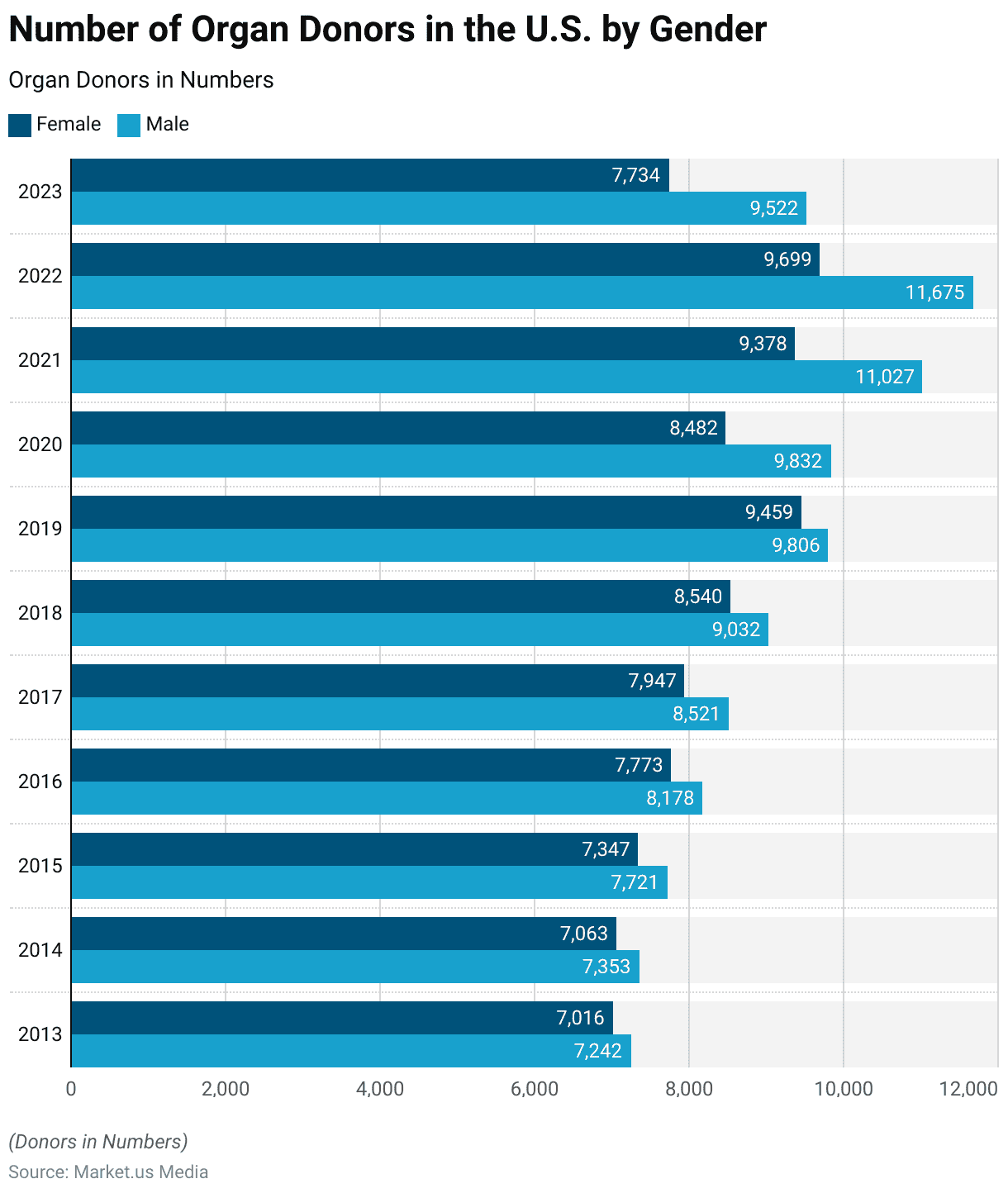
Organ Transplants: Donation After Brain Death – By Organ Statistics
- In the United Kingdom (UK), during 2022/23, organ transplant donations after brain death varied across different organs.
- Kidney transplants were the most common, with 1,203 procedures performed.
- Liver transplants followed, totaling 523. There were 158 heart transplants and 93 liver lobe transplants.
- Combined kidney and pancreas transplants accounted for 81 procedures.
- Double lung transplants were performed 55 times, while single lung transplants occurred in 7 cases.
- Pancreas transplants were the least common, with only five procedures conducted.
- This data highlights the distribution of various organ transplants from donors after brain death in the UK.
(Source: Statista)
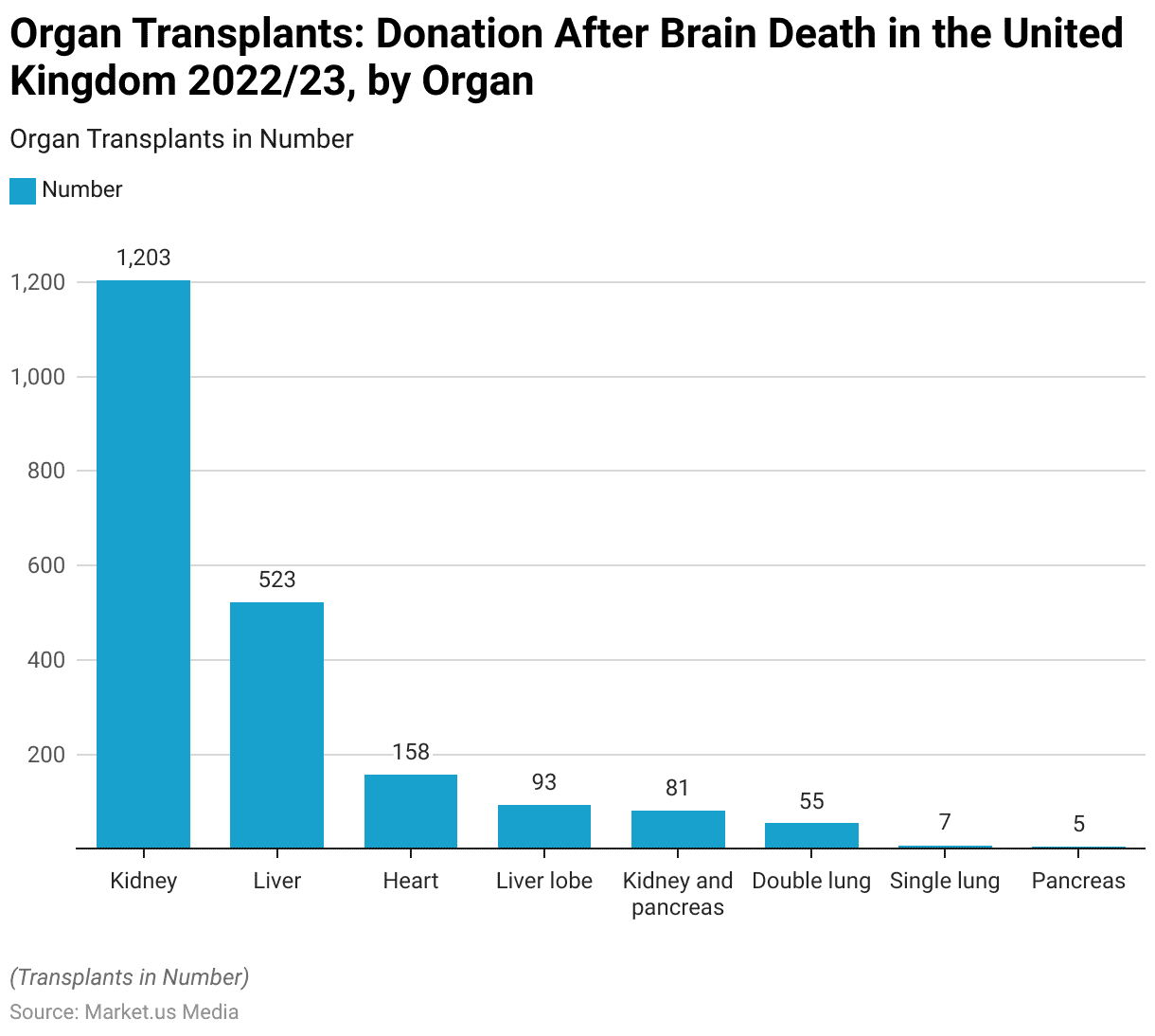
Deceased Organ Donor Rate After Brain Death (DBD) and Donation After Cardiac Death (DCD)
- In Europe, the rate of deceased organ donors, including both donation after brain death (DBD) and donation after cardiac death (DCD), varied significantly across countries in 2021 and 2022.
- Spain had the highest rates, with 46.7 donors per million population in 2022, up from 40.8 in 2021. Portugal followed, with an increase from 29.6 in 2021 to 31.5 in 2022.
- Belgium’s rate rose from 26.9 to 29.2, and Czechia saw an increase from 25 to 27.9. France reported a slight increase from 24.7 to 25.8, and Slovenia experienced a significant rise from 19.5 to 25.7.
- Italy’s rate increased from 24.1 to 25, and Austria’s from 20.2 to 24.4. Croatia saw a decrease from 29.5 to 23.2.
- The United Kingdom’s rate increased from 19.8 to 20.6, while Finland’s rate decreased from 22.2 to 20.4. Norway saw an increase from 17.5 to 20.2, and Estonia from 16.2 to 19.2.
- Switzerland experienced a slight decrease from 19.1 to 18.6. Ireland saw a significant increase from 13 to 17.2, while Lithuania’s rate decreased from 18.9 to 17.
- The Netherlands increased from 15.9 to 17, and Slovakia from 10.9 to 12.9. Hungary’s rate rose from 10.6 to 12.7, and Poland from 10.5 to 11.8.
- Germany’s rate decreased from 11.1 to 10.4, and Sweden saw a significant drop from 19.3 to 10.2. Greece’s rate increased from 5 to 6.7, and Romania from 2.5 to 4.5.
- Cyprus experienced a decrease from 4.2 to 3.3, while Bulgaria’s rate remained low, with a slight decrease from 2.5 to 2.1.
- This data highlights the varying trends and fluctuations in organ donation rates across European countries.
(Source: Statista)
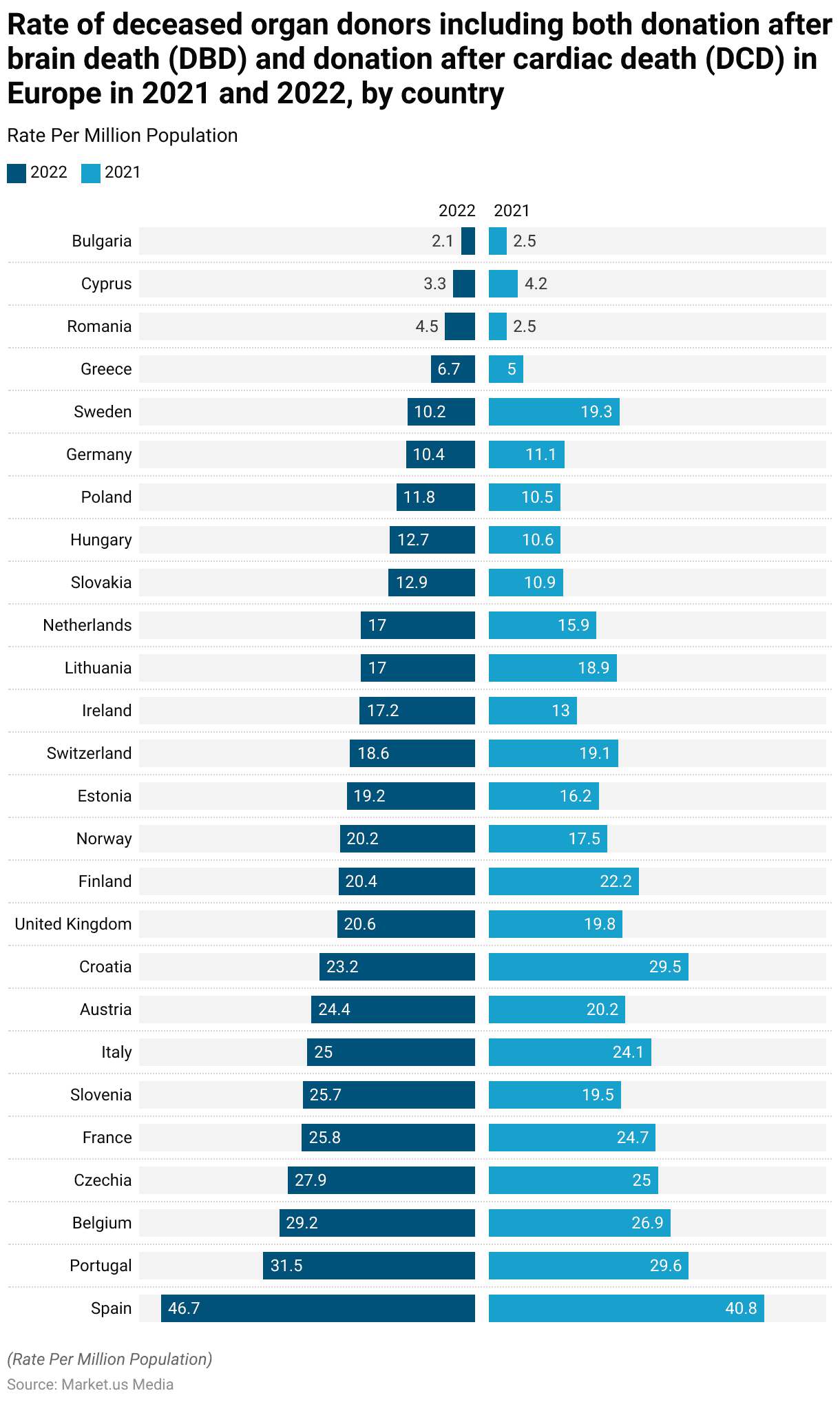
Candidates Waiting for Organ Transplants
- As of November 2023, the number of candidates waiting for organ transplants in the United States totaled 103,650.
- The majority of these candidates, 88,822, were awaiting kidney transplants.
- Liver transplant candidates numbered 10,049, while those waiting for pancreas transplants totaled 830.
- Candidates waiting for both kidney and pancreas transplants accounted for 2,004 individuals.
- Heart transplant candidates numbered 3,398, and those waiting for lung transplants totaled 935.
- 33 candidates were awaiting heart-lung transplants, and 203 were waiting for intestine transplants.
- Additionally, there were a small number of candidates waiting for other types of transplants, including abdominal wall (3), VCA-head and neck (4), VCA-upper limb (3), and VCA-uterus (9).
- This data underscores the diverse needs of organ transplant candidates across various organ types in the US.
(Source: Statista)
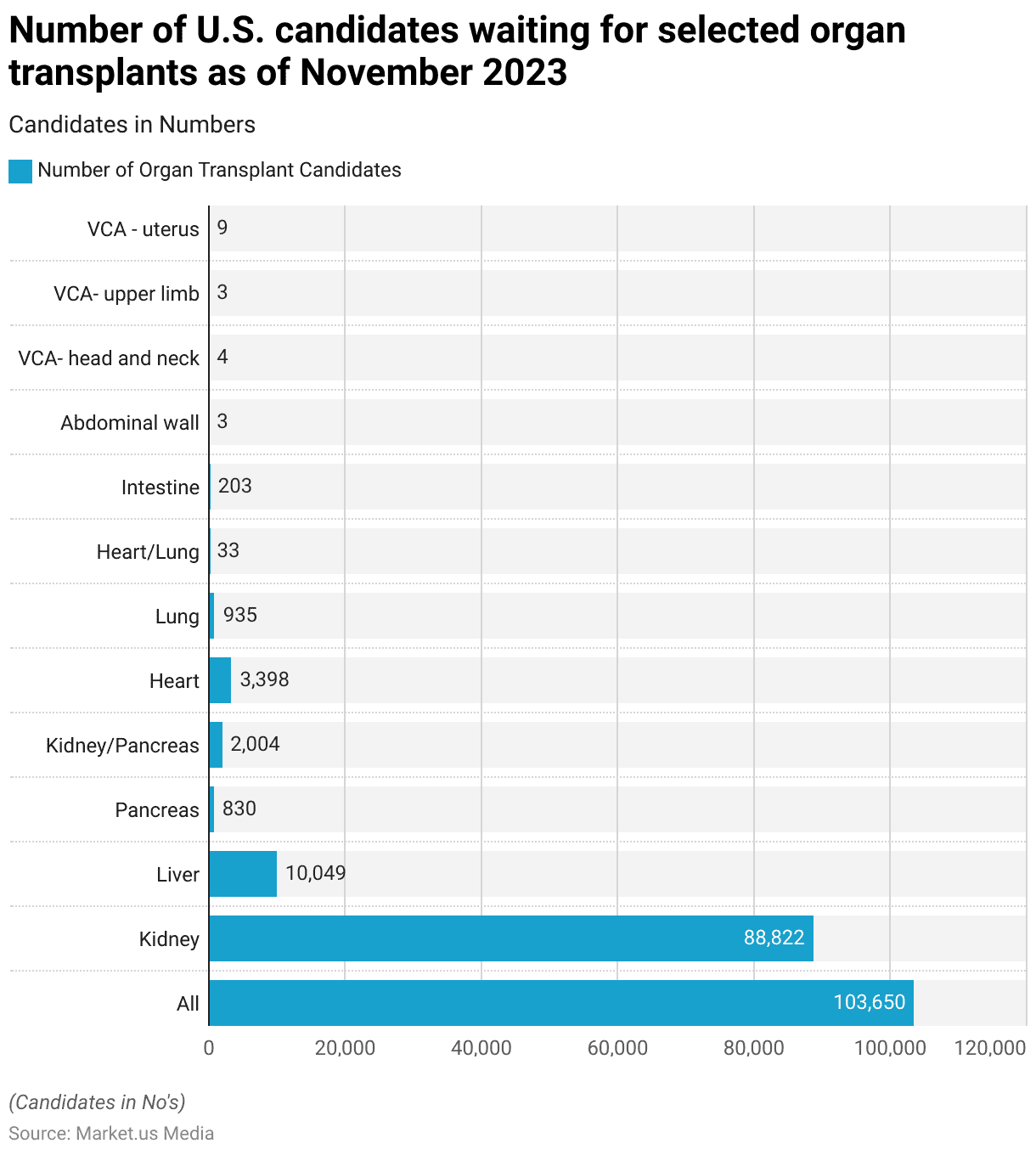
Key Cost Metrics
- As of 2020, the average amount charged for various organ transplantations in the United States varied significantly by organ.
- Heart transplants were the most expensive, with an average cost of $1,664,800.
- Intestine transplants followed, costing $1,240,700 on average.
- Allogenic bone marrow transplants averaged $1,071,700, while single lung transplants cost $929,600.
- Liver transplants were billed at an average of $878,400.
- Autologous bone marrow transplants had an average cost of $471,600, and kidney transplants averaged $442,500.
- Pancreas transplants were billed at $408,800 on average, while corneal transplants were the least expensive, costing $32,500.
- This data highlights the substantial financial burden associated with various types of organ transplantation procedures in the US.
(Source: Statista)

Important Sources of Information on Organ Donation Statistics
- In 2012, US adults identified several important sources of information on organ donation.
- News coverage, including TV, radio, newspapers, and the Internet, was the most cited source, with 69.9% of respondents indicating it as their information source.
- Discussions with family members were also significant, mentioned by 52.6% of respondents, followed by conversations with friends at 49.4%.
- Advertisements on TV informed 47.1% of individuals, while motor vehicle offices were a source for 45.1%.
- Movies and TV shows contributed to awareness for 40.4% of respondents, and billboards or posters in public places were noted by 35.2%.
- Information from medical professionals, clinics, or doctor’s offices was important for 35.1%, and health-related or other websites were cited by 34.9%.
- Radio advertisements informed 25.9% of respondents, while personal experiences or involvement with organ, eye, and tissue donation influenced 25.2%.
- Work or school environments were sources for 24.2%, and organ and tissue donation organizations for 22.7%.
- Social media platforms such as Facebook, YouTube, or Twitter were mentioned by 21.6%, and community activities like health fairs by 20.4%.
- Senior centers or other older adult settings were sources for 9.4% of respondents, clergy members of religious organizations for 5.9%, and attorneys for 2.3%.
- This data highlights the diverse range of information sources on organ donation among US adults.
(Source: Statista)
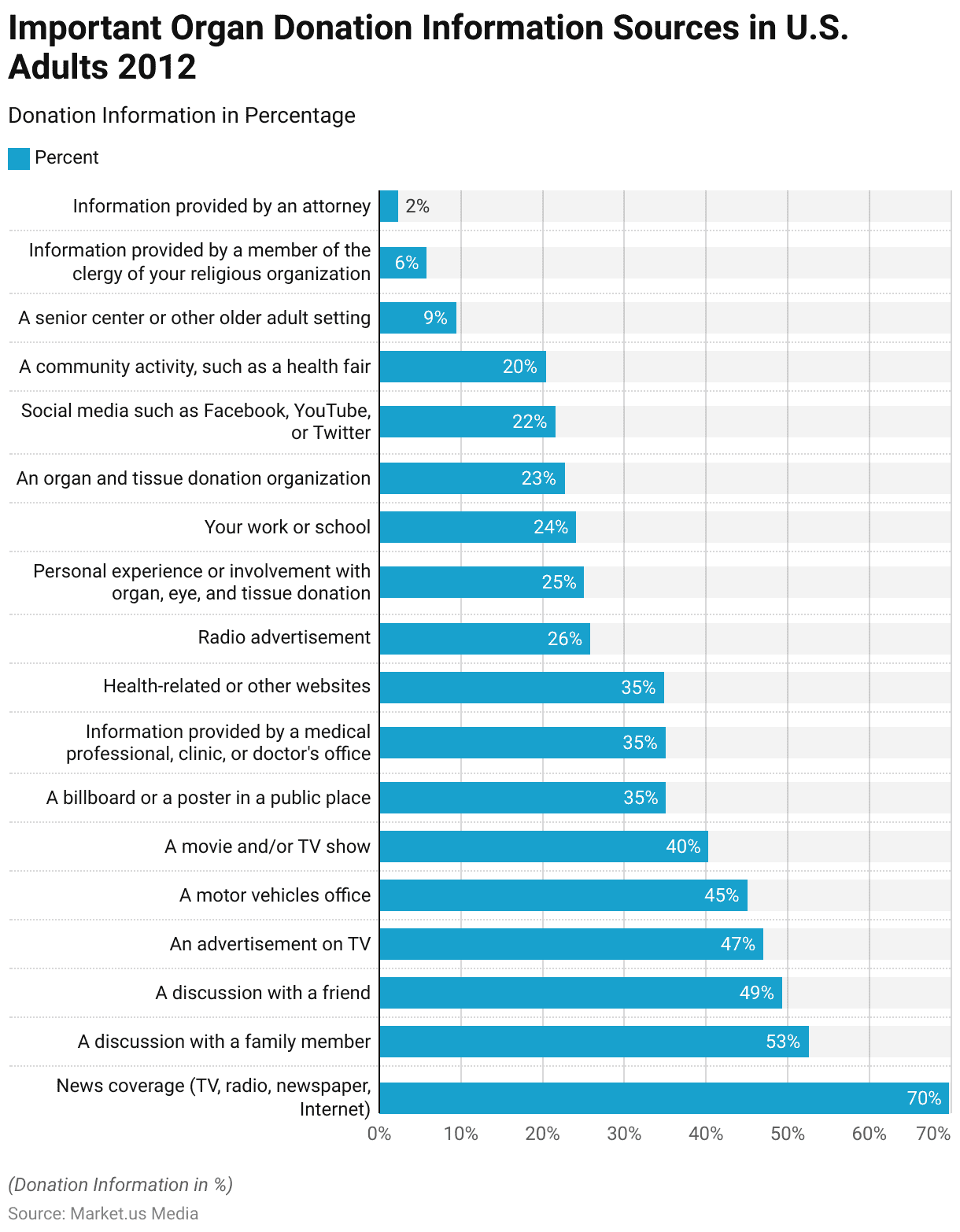
Investments in Organ Donation Statistics
- Investments in organ donation have significantly increased, driven by various organizations aiming to improve the system’s efficiency and reach.
- For instance, the Health Resources and Services Administration (HRSA) proposed a $36 million increase in the fiscal year 2024 budget, totaling $67 million for organ procurement and transplantation modernization initiatives.
- This initiative aims to enhance IT systems, operational efficiency, and governance structures to improve overall outcomes.
- Additionally, the Association of Organ Procurement Organizations (AOPO) reported that US organ procurement organizations successfully transplanted 43,000 organs in 2023, marking a consistent growth trend over the past 13 years.
- These investments are crucial for addressing the growing demand for organ transplants and ensuring that the system continues to save and improve lives efficiently.
(Sources: Health Resources and Services Administration, UNOS, The Alliance)
Popular Organ Donation Programs Statistics
- Several prominent organ donation programs have significantly contributed to saving lives through their structured initiatives and extensive outreach.
- The United Network for Organ Sharing (UNOS) manages the national transplant system. It operates the Organ Procurement and Transplantation Network (OPTN), focusing on equitable organ allocation and advancing transplantation technology and policy.
- In 2023, UNOS facilitated over 46,000 transplants, setting new records for kidney, liver, and lung transplants.
- Donate Life America is another key organization that promotes donor registration and awareness through national campaigns like National Donate Life Month and various local initiatives aimed at increasing donor registrations and educating the public about the importance of organ, eye, and tissue donation.
- Additionally, the UT Southwestern Medical Centre’s Transplant Program, known for its high success rates and innovative techniques, provides comprehensive care from initial evaluation through post-transplant recovery, contributing to the field with significant numbers of kidney, liver, lung, and heart transplants.
- These programs, among others, play a crucial role in enhancing organ donation and transplantation efforts nationwide.
(Sources: UNOS, OPTN, Donate Life America, UT Southwestern Medical Center)
Regulations for Organ Donation Statistics
- Organ donation regulations vary widely by country, focusing on ethical practices, donor consent, and the prevention of organ trafficking.
- In the UK, an opt-out system, known as deemed consent, is in place across England, Wales, Scotland, and Northern Ireland, meaning individuals are considered willing donors unless they explicitly opt out.
- This system aims to increase the number of available organs for transplant while maintaining ethical standards.
- In the UAE, the Federal Decree-Law No. 25 of 2023 regulates organ and tissue transplantation, prohibits organ trafficking, and mandates the registration of donors through the national HAYAT registry linked to each individual’s Emirates ID.
- Globally, the World Health Organization (WHO) emphasizes the need for strict regulations to ensure the safety and ethical procurement of organs, advocating for systems that prevent exploitation and trafficking.
- These frameworks aim to enhance the effectiveness of organ donation programs while safeguarding the rights and health of donors and recipients.
(Sources: NHS – Organ Donation, U.ae, WHO)
Recent Developments
Acquisitions and Mergers:
- CareDx acquires XynManagement: In mid-2023, CareDx, a company specializing in transplant diagnostics, acquired XynManagement, a provider of transplant patient management solutions, for $50 million. This acquisition aims to enhance CareDx’s portfolio in patient care and post-transplant monitoring.
- TransMedics acquires OrganOx: In late 2023, TransMedics acquired OrganOx, a company known for its organ preservation technology, for $120 million. This merger is expected to strengthen TransMedics’ position in organ preservation and transportation, improving the viability of donated organs.
New Product Launches:
- TransMedics’ OCS Heart System: In early 2024, TransMedics launched the OCS Heart System, a new organ care system designed to preserve and monitor hearts outside the body for extended periods. This system aims to increase the success rate of heart transplants by ensuring better organ quality.
- Paragonix SherpaPak: Paragonix Technologies introduced the SherpaPak Lung Transport System in mid-2023, offering advanced preservation technology for lung transplants. This product aims to improve lung transplant outcomes by maintaining optimal conditions during transportation.
Funding:
- Organ Recovery Systems secures $75 million: Organ Recovery Systems, a leader in organ preservation technologies, raised $75 million in a funding round in 2023 to expand its product offerings and enhance its R&D capabilities, focusing on improving organ preservation and transportation.
- Omnicyte raises $50 million: In early 2024, Omnicyte, a company specializing in regenerative medicine and organ preservation, secured $50 million to develop new technologies aimed at extending the viability of donated organs and improving transplant success rates.
Technological Advancements:
- AI and Machine Learning in Organ Matching: Advances in AI and machine learning are being applied to improve organ matching algorithms, increasing the accuracy and speed of matching donors with recipients, and potentially reducing wait times for transplants.
- Advanced Organ Preservation Techniques: New preservation techniques, such as normothermic perfusion and cryopreservation, are being developed to maintain organs in better condition during transport and storage, increasing the success rates of transplants.
Market Dynamics:
- Growth in Organ Donation Market: The global organ donation market is projected to grow at a CAGR of 8.5% from 2023 to 2028, driven by increasing awareness about organ donation, advancements in transplant technologies, and supportive government initiatives.
- Rising Demand for Transplants: There is a growing demand for organ transplants due to the rising prevalence of chronic diseases such as diabetes, kidney disease, and heart failure, leading to an increased need for organ donors.
Regulatory and Strategic Developments:
- EU Organ Donation Directives: The European Union updated its organ donation directives in early 2024, focusing on improving the safety and quality of organs intended for transplantation, and promoting cross-border organ exchanges to optimize organ allocation.
- US Organ Procurement and Transplantation Network (OPTN) Policy: The US OPTN has implemented new policies in 2023 to enhance organ allocation processes, increase transparency, and ensure equitable access to transplants for all patients on the waiting list.
Research and Development:
- Xenotransplantation Research: R&D efforts are focusing on xenotransplantation, the transplantation of organs from other species, particularly pigs, to humans. This research aims to address the organ shortage crisis by providing an alternative source of organs.
- Bioprinting and Regenerative Medicine: Researchers are exploring the use of bioprinting and regenerative medicine to create lab-grown organs, which could potentially eliminate the need for organ donors and revolutionize the field of transplantation.
Conclusion
Organ Donation Statistics – Organ donation is vital for saving lives and improving the quality of life for many patients worldwide.
However, there remains a significant gap between the number of organs needed and those available. Data from 2022 and 2023 highlight regional disparities in donation rates and transplant numbers, influenced by cultural, medical, and infrastructural factors.
Moreover, High costs and varying levels of public awareness further complicate the issue. Enhancing public education, improving donor registration, and addressing financial and logistical barriers are crucial steps in increasing donor numbers.
Organ donation is a life-saving act that requires ongoing support and advocacy to bridge the gap between supply and demand.
FAQs
Organ donation is the process of giving an organ or a part of an organ for transplantation to another person. It can occur after the donor has died or while the donor is still alive.
Most people can become organ donors regardless of age, race, or medical history. The suitability for donation is determined by medical professionals based on the condition of the organs at the time of death or donation.
Organs that can be donated include the heart, lungs, kidneys, liver, pancreas, and intestines. Tissues such as corneas, skin, bone, heart valves, and blood vessels can also be donated.
There is no strict age limit for organ donation. New-borns, as well as senior citizens, have successfully donated organs. The condition of the organs is more important than the donor’s age.
Donated organs are matched to recipients based on several factors, including blood type, tissue type, organ size, medical urgency, time on the waiting list, and geographic location.
Discuss your needs with our analyst
Please share your requirements with more details so our analyst can check if they can solve your problem(s)



